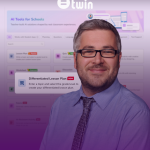This blog was last updated on 24 July 2025
This blog is presented by Twin Science, a global education technology company empowering educators through AI-enhanced solutions.
What Is AI Literacy, and Why Does It Matter for Teachers?
How does AI literacy impact the modern classroom, and why should educators care? AI literacy, the ability to understand and responsibly use artificial intelligence, has quickly become essential in today’s education landscape. As AI in Education transforms both what and how we teach, educators such as yourself face a critical challenge: How can you guide students in an AI-driven world if they haven’t built AI literacy themselves?
At Twin, we know that navigating new technology can feel daunting. You’re not expected to do it alone. Our vision is to walk beside you, offering gentle support and practical tools as you help your students thrive in a changing world.
If you’ve ever wondered where to start with AI or how to translate new technology into real classroom value, you’re not alone. We’ve developed hands-on learning solutions that help teachers as yourself explore classroom-ready tools, discover practical AI resources, and bring STEM to life for every learner.
Get your classroom started with hands-on AI tools today.
Where Are the Gaps in AI Literacy for Teachers?
What are the real obstacles preventing educators from building AI literacy? Many teachers feel left out of the AI conversation, often due to limited training, a lack of clear resources, and the fast pace of edtech innovation. Terms like “machine learning” or “algorithmic bias” can feel overwhelming, especially without direct classroom examples or teacher-focused guidance.
As schools adopt more AI tools and STEM content, educators need practical, reliable pathways to build confidence, not just with theory, but with classroom-tested strategies. As AI becomes a daily part of student life, it’s essential to equip classrooms now. Start using teacher AI tools and get access to Twin Science learning solutions that make AI literacy both accessible and actionable.
How Can Educators Build AI Literacy With Confidence?
What are the most effective ways to develop AI literacy in practical, classroom-focused ways? Successful AI literacy programs start with hands-on, teacher-friendly approaches. This could mean using STEM solutions for real-world problem solving, integrating AI-powered edtech platforms that offer clear guidance, or participating in professional development aligned with ISTE standards.
You don’t need to become an AI expert overnight. With Twin, you have a companion to help you take small, meaningful steps, so you can focus on connecting with your students and making learning real.
What Misconceptions Are Holding Teachers Back?
Why do some educators hesitate to integrate AI in their classrooms? A common barrier to AI adoption in education is the belief that it’s only for tech experts or computer science teachers. But AI in education isn’t about mastering complex algorithms, it’s about recognizing AI’s role in everyday tools like search engines, learning apps, or even digital grading systems.
Educators such as yourself may also worry that AI will replace their role, when in fact, it enhances your ability to personalize instruction, give feedback, and create adaptive learning environments. Breaking down these myths starts with showing teachers how AI tools fit into what they already do.
How Can Schools Build a Culture of AI Literacy?
What can schools do to support long-term AI readiness among staff? AI literacy cannot rest on individual teachers alone. To create sustainable impact, schools need to embed AI into professional development, curriculum planning, and technology adoption strategies.
This means aligning PD with frameworks like ISTE standards, ensuring leadership supports classroom experimentation, and providing time for teachers to explore AI tools together. Schools that invest in hands-on learning environments, peer training, and cross-disciplinary collaboration see faster adoption and deeper impact.
Why Now? Preparing Classrooms for an AI-Driven Future
How can teachers take meaningful first steps starting today? The need for AI literacy is urgent and growing. With AI already shaping everything from personalized learning to real-time feedback, the sooner educators build confidence with these tools, the more empowered their students will be.
We’re here to help you feel supported and valued as you lead your classroom into the future, with heart, with confidence, and always with compassion. With Twin by your side, you never have to take this journey alone.
Start by selecting accessible, classroom-tested resources that align with your STEM goals and make AI a living part of daily learning.






